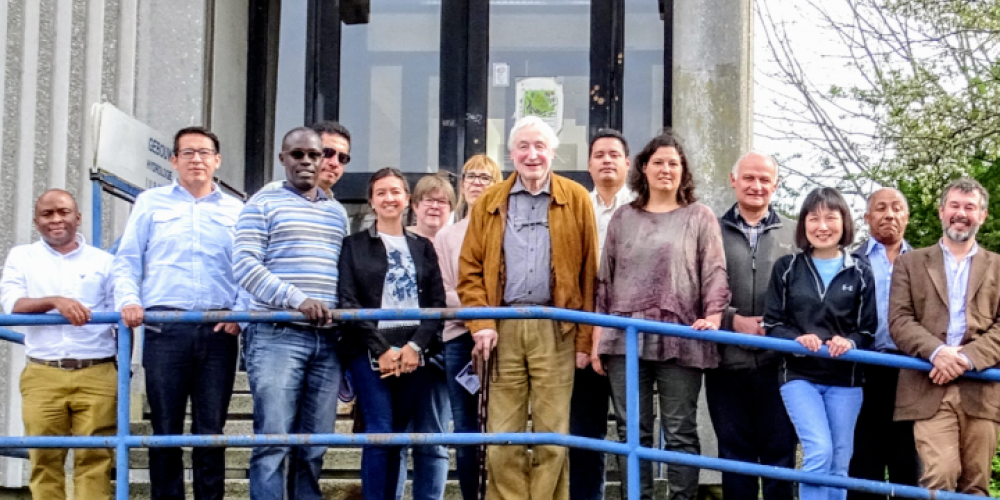
NULL
Text: Michael Akinbolusere
The Interuniversity Program in Water Resources Engineering (IUPWARE), a joint international Masters’ program of Vrije Universiteit Brussels and KU Leuven, is a clear example of the added value of bringing together experts from distinct cultural backgrounds that are confronted with diverse water-related issues. The program not only stimulates the exchange of a wide variety of knowledge, but also the acquisition of skills that are highly useful in professional life. Approximately 100 alumni of the IUPWARE-program converged in Belgium to exchange expertise on water related management issues. On the 28-31 of March 2017, the latest alumni event and water cloud symposium took place in Brussels and Leuven, Belgium. The theme was about the latest evolutions in water engineering: hydrological modelling and cloud computing.
The Warming of the Ocean Phenomenon in Ecuador
Dr. Raul F. Vazquez, an Ecuadorean civil engineer and one the participants, stated that in his home nation, there is a phenomenon known as the warming of the ocean, wherein significant amount of unusual rainfall and drought occur in certain areas. Infrastructural damage, minimal economic deficit, disasters and loss of lives are inevitable.
Decades ago, there was an information deficit regarding water resources management. Currently, new algorithms and cutting-edge technology are used to run water-related complicated models. These models are necessary to process and analytically make sense of innumerable information to produce credible output data. The scientific-based, accurate and sophisticated output data gotten from respective models enhances the efficient application of solution to water-related issues without any detrimental margin of error. Moreover, these models in water resources management help forecast climate measures and mitigate potential effect of the aforementioned issues on a global scale. In the absence of the innovation that hydrological modelling and cloud computing provides, water-related issues will go unresolved.
On that regard, tons of information derived from satellite needs the competency of these models in order to efficiently measure the qualitative output data and apply the results by resolving respective water-related issues. According to Prof. Ann Van Griensven (photo: left), hydrological programming models are top-notch software packages used for advanced-computing calculations. Cloud computing calculations, in her opinion, are made via the use of formidable computing power infrastructure that are typically more powerful than a typical desktop computer with the aid of Internet access. For instance, these calculations can be utilized to measure the volume of water in a water cycle process. With infiltration and evapotranspiration and transport of water, these models and advanced-computing can help predict in time and space, the volume of water in the river and water quality variables like oxygen, nutrients, and organic pollution.
Reliable Information for Local and International Decision Makers
Dr. Raul F. Vazquez Z. stipulates that the hydrological models that are used in order to produce reliable information eventually helps foster the consensus for essential decision making process for policy makers; both locally and internationally.
In due course, the use of cloud infrastructure and higher performance computing will reach its innovative peak. Several technologies that are currently under development, paint a picture of innovative water resources solutions. Prof. Ann Van Griensven adds that for instance, the use of social media like Twitter can foster information collection, if relevant messages can help pin-pin location of flood and water disasters. The idea of where and when these disasters occurred makes information collection easier for long-lasting solution-oriented implementations.
Water Management in the Bolivian Amazon
One important element of water management is to set up a planning; a program of measures for basins and models that can be used to help predict the impact of certain measures.
One innovative solution to water disaster is the Delft-FEWS, which is an early warning model that has been developed and implemented for an area as large as 247.450,00 km2 in the Bolivian Amazon. It forecasts and mitigates environmental issues as a result of hydrological and cloud computing innovation. During the Brussels symposium, Dr. Ing. Mauricio F. Villazón stated: “a modelled basin size of the Delft-FEWS can help predict 14 days of forecasting – 7 days forecast and 7 days flood travel”.
Enhancing International Collaboration for a Long-lasting Effect
Dr. Fekadu Mored emphasized "tackling the challenges in water resources management should focus on providing worldwide long-term solutions". As an example, he disclosed the issues of drought and flood in sub-Saharan Africa.
For this reason, IUPWARE is at the forefront of new evolutions in water resources teaching and research, which focuses on innovative modelling for effective integrated water management. The Belgian Ministry for Development Cooperation, through VLIR-UOS, funds the scholarships that support IUPWARE students and professionals. According to the director of VLIR-UOS – Mrs. Kristien Verbrugghen – it aims to trigger and support the internationalisation and globalisation of higher education in the Flemish-speaking part of Belgium – Flanders. By rubbing minds in order to exchange information, knowledge, ideas and experiences, it promotes live-changing innovation for the South and beyond.
Tackling the challenges in water resources management should focus on providing worldwide long-term solutions.
During the partners meeting in Brussels, intensive discussions took place between the private sector and the teaching and research sector. The private sector partners are HydroScan, AGT and institutions in both Flanders and in the South. The meeting aims to establish a consortium of industry and academia, while cultivating innovative ideas in the water sector. Cooperative projects between higher institutions in Flanders and the South fosters innovative responses to global and local challenges as a result of ‘out of the box thinking’ that triggers, facilitates and advances innovation.
With the sole aim to ‘tear down walls’, VUB is proudly part of this collaboration. Since research and education is simply the starting point for VUB, it connects innovative minds that inspire continual learning, advancement of expert knowledge and culture sharing in order to efficiently tackle global issues.